
Study: 7 findings on the coming out experience of trans women and trans-oriented men
Since many LGBTQIA+ individuals around the world experience coming out every year, we celebrate National Coming Out Day on October 11 annually. My Transgender Date wanted to do something a little different this year, so our team carried out a small study to gauge the coming out experience of trans women and trans-oriented men.
For most people, coming out is the beginning of a new chapter in life. It can be positively life-altering for some. But for others, it can have negative consequences. What motivates people to come out despite the challenges? What exactly are the fears and losses LGBT people experience because of their own coming out? Through our study, we can have a clearer picture regarding these topics.
- Finding 1: Trans women are 3 times more likely to come out than trans-oriented men
- Finding 2: Friends and mothers are favorite persons to come out to first
- Finding 3: One in ten closeted respondents declare wanting to come out to their spouse first
- Finding 4: Trans women come out at a younger age compared to trans-oriented men
- Finding 5: There are negative consequences to coming out (for some)
- Finding 6: Closeted respondents have high fears of coming out
- Finding 7: Coming out is not as bad as people expect
On this page
- Terminologies
- Methodology
- Findings
- 1. Trans women are 3 times more likely to come out than trans-oriented men
- 2. Friends and mothers are favorite persons to come out to first
- 3. One in ten closeted respondents declare wanting to come out to their spouse first
- 4. Trans women come out at a younger age compared to trans-oriented men
- 5. There are negative consequences to coming out (for some)
- 6. Closeted respondents have high fears of coming out
- 7. Coming out is not as bad as people expect
- Conclusion
Terminologies
This article contains LGBT vocabulary and slang for the sake of simplicity and readability.
Trans-oriented refers to a person who is romantically attracted to trans people. Here we specifically surveyed trans-oriented men who are attracted to trans women.
Coming out (of the closet) is a metaphorical expression to describe when an LGBT person opens up about their sexual orientation (lesbian, gay, bisexual) or gender identity (trans).
Closeted (or being in the closet) refers to an LGBT person who hasn’t come out yet. Here we talk about closeted trans women, trans-oriented men or respondents.
To be out (of the closet) refers to an LGBT person who has already come out. Here we talk about trans women, trans-oriented men or respondents who are out.
Methodology
We’ve asked respondents from all over the world to answer a series of questions related to coming out. The full list of questions used in this survey is available for your information here.
All respondents are members of My Transgender Date (a popular dating site for trans women) and include trans women and trans-oriented men, who are either out or closeted.
In total, there were 5,518 unique answers, with 64.5% of the respondents identifying as trans-oriented men and 35.5% as trans women.
We surveyed 136 different countries and translated our questions into 5 different languages — specifically English, French, German, Spanish, Italian, and Portuguese. This ensured that our respondents could understand and confidently answer our survey.
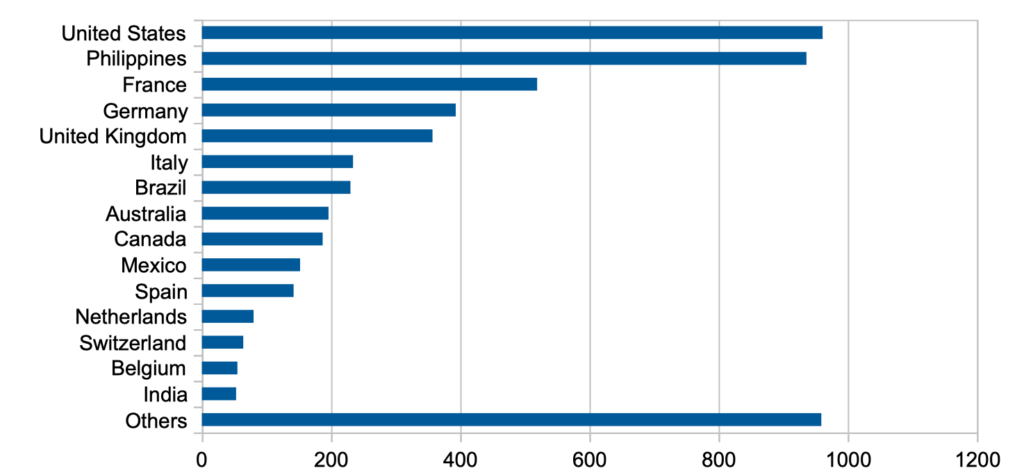
Fig 1. Countries distribution of respondents
The average age of the respondents is 40.7 years and the median age is 38.

Fig 2. Age distribution of respondents
Findings
At the end of our survey period, we have gathered significant data to help us better understand the coming out experience of trans women and trans-oriented men. The results varied between trans women and trans-oriented men since their coming out experiences differ. The difference lies in gender identity (trans women) versus sexual orientation (trans-oriented men). Here are 7 of our most interesting findings.
1. Trans women are 3 times more likely to come out than trans-oriented men
84% of trans women surveyed are out, while it’s only 25% for trans-oriented men. In fact, 42% of trans-oriented men said they won’t or can’t come out.
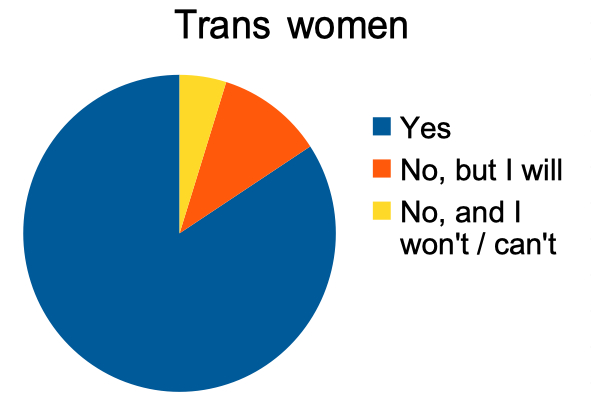
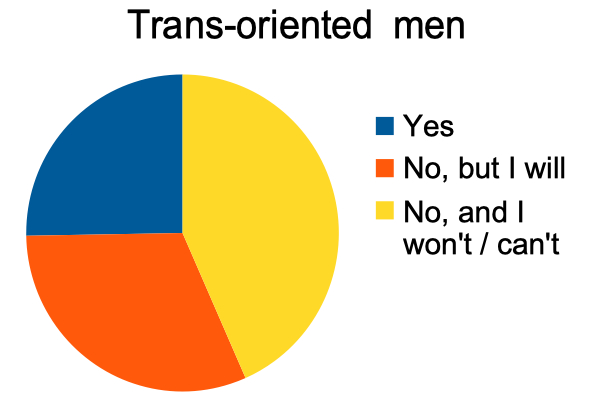
Fig 3. Answers to “Did you come out yet?”
This shows that coming out isn’t really a choice for trans women, because it is part of the process and experience of transitioning and living their true selves.
We asked closeted trans women what was preventing them from coming out. Here are some answers:
“Workplace issues, loss of long time friends, potential family conflicts”
“Family and friends wouldn’t accept me”
“Being tagged and classified”
“I live in Russia”
“In a relationship”
“Family and coworkers who wouldn’t understand”
For trans-oriented men, this is different. Sexual orientation is easier to hide than gender identity, therefore it’s understandable that they have less pressure and fewer reasons for coming out compared to trans women.
Likewise, we asked trans-oriented men what was preventing them from coming out. Here are some answers:
“It’s my private life. Besides, people aren’t ready to find normal that a man loves trans women.“
“I would be killed“
“My wife wants to be a woman. She is now accepted by everyone as a woman..Why would we want to now tell people that she is not a woman”
“I dont consider myself to be gay, I am attracted to trans because they are women, different parts but still a woman”
“I don’t feel the need to come out, since I consider myself straight”
“I don’t feel that I am anything but a straight male, and therefore coming out is unnecessary”
This remains a profound question to answer. Should trans-oriented men open up about their attraction to trans women? Would this lead to more acceptance of trans people and normalization of trans relationships? Probably so.
2. Friends and mothers are favorite persons to come out to first
Findings show that trans women choose to come out to their mothers first, while trans-oriented men have a higher chance of coming out to their friends first.
📌 41% of trans women came out to their mothers first, while 27% came out to their friends first.
📌 47% of trans-oriented men came out to their friends first, while 15% of them came out to their mothers first.
This is probably explained by the fact that trans women feel they are more likely to be accepted when coming out to their mother as they don’t have to worry about the possible macho mentality (where a man earns respect by having characteristics believed to be typically male) of the other men in the family.
3. One in ten closeted respondents declare wanting to come out to their spouse first
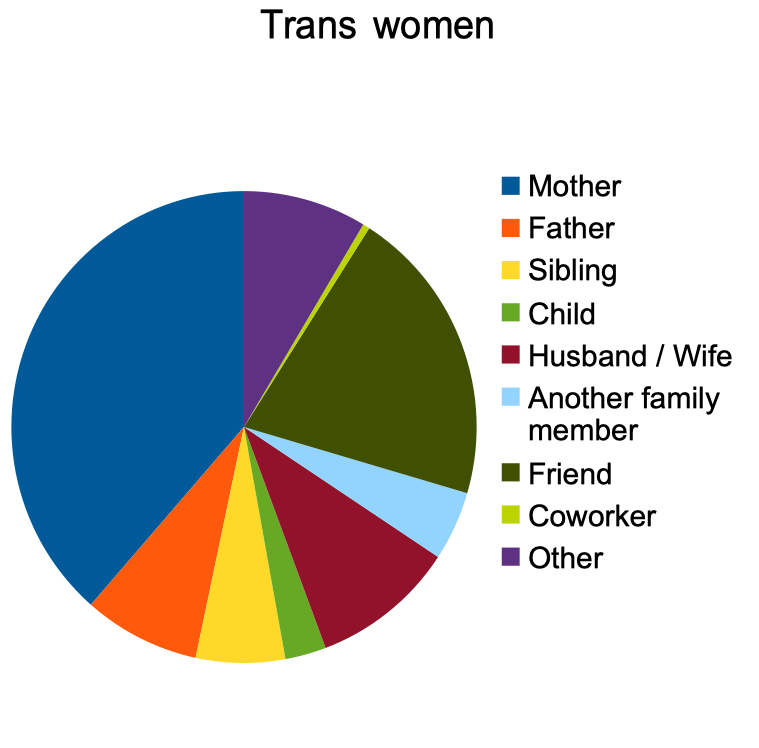
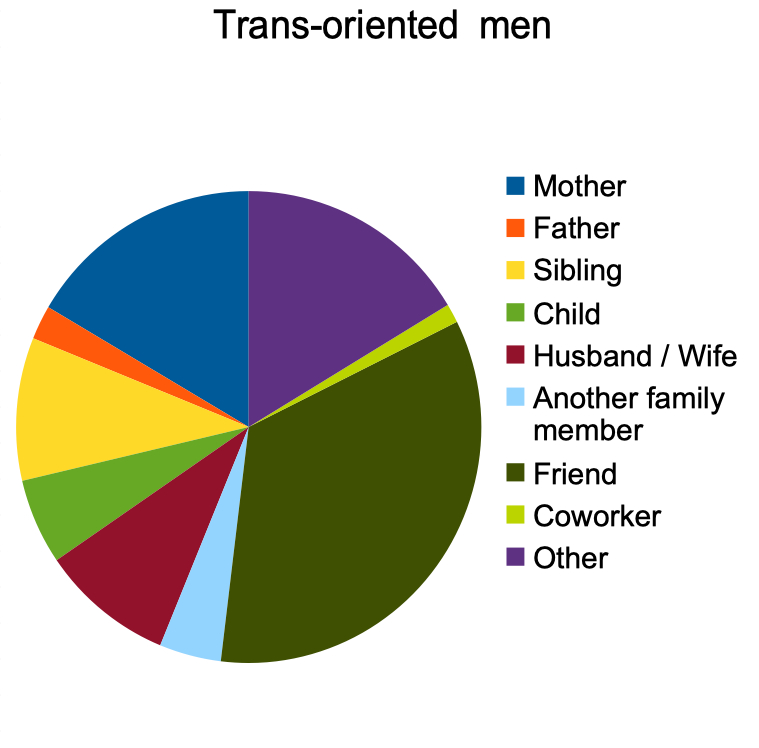
Fig 4. Answers to “Who’s the first person you want to come out to?”
This number highlights the situation of closeted trans women and trans-oriented men who aren’t able to express their true selves. They may be forced to lead a heteronormative life (e.g. marriage, children), and in some cases, a double life.
Caitlyn Jenner would be the most notorious and mediatized illustration of such a situation. She came out as a trans woman at age 65, after being married to three women and having 6 children. She declared experiencing gender dysphoria since childhood, and that this contributed to ending her last marriage with Kris Kardashian.
4. Trans women come out at a younger age compared to trans-oriented men
The majority of trans women come out during childhood and young adult life (82% before age 30).
For trans-oriented men, the majority come out later in life (75% between the ages 19-39).
The numbers above can be attributed to gender identity versus sexuality, where trans women may discover they are trans at an earlier age (childhood), while trans-oriented men find out about their preferences for trans women when they naturally explore their sexuality (teenage years to late adulthood).
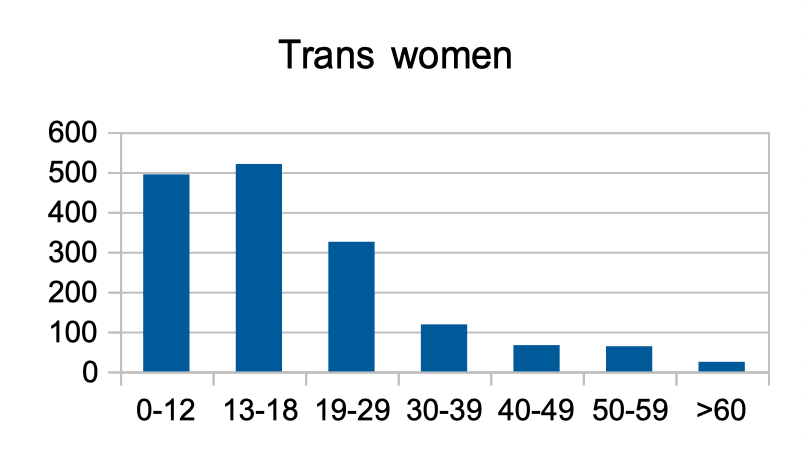
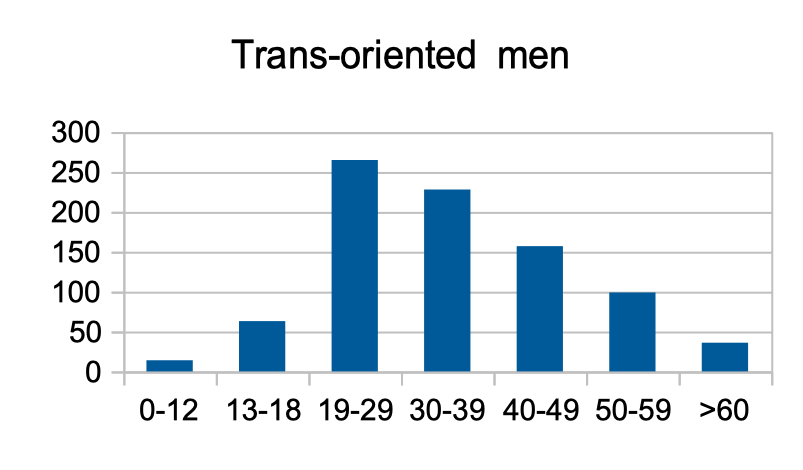
Fig 5. Answers to “At what age did you come out?” for all respondents
These numbers should be taken with a grain of salt though. It also depends on what country the respondents come from.
Almost all trans women in our audience from the Philippines have come out before age 30 compared to those in the United States who come out at a much older age. This can be explained by the fact that Filipino society is culturally more accepting of trans women than that of western societies.
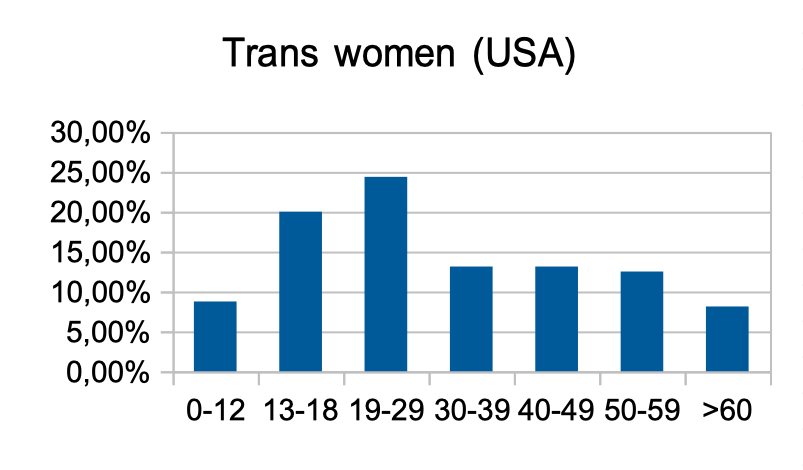
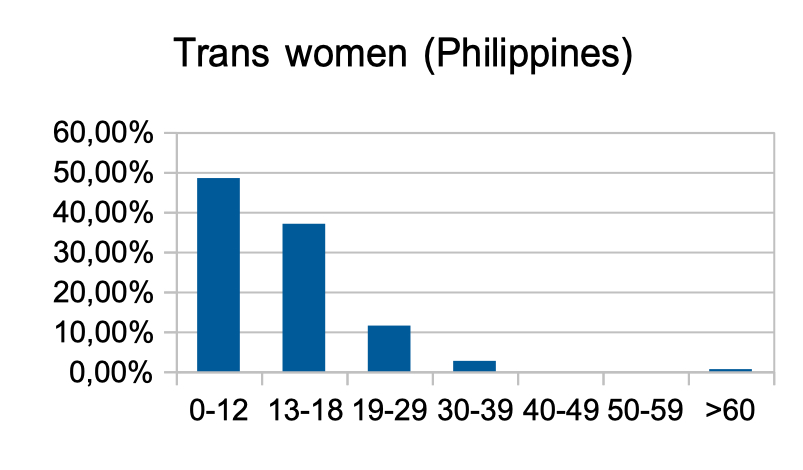
Fig 6. Answers to “At what age did you come out?” for USA and Philippines
5. There are negative consequences to coming out (for some)
Some of our respondents experienced negative consequences after coming out. The results below show that roughly a quarter of the respondents have lost jobs / job opportunities, family, and friends after coming out.
📌 1 in 4 trans women who have come out lost their job or a job opportunity (26%).
📌 1 in 4 trans women who have come out lost family (27%).
📌 1 in 5 trans-oriented men who have come out lost family (18%).
📌 1 in 3 respondents who have come out lost friends (31% for trans women, 28% for trans-oriented men).
6. Closeted respondents have high fears of coming out
Respondents who have yet to come out are more likely to have high fears about coming out. The numbers below suggest that almost half or at least half of the respondents are scared to lose their jobs or job opportunities, friends, and family.
📌 1 in 2 closeted trans women are afraid to lose their job or a job opportunity (49%).
📌 1 in 2 closeted respondents are afraid to lose friends (49% for trans women, 57% for trans-oriented men).
📌 2 in 5 closeted respondents are afraid to lose family (42% for trans women, 47% for trans-oriented men).
7. Coming out is not as bad as people expect
We observed a substantial difference between the negative expectations of closeted respondents (see finding 6) and the experienced reality of respondents who have come out (see finding 5). This is seen in all the questions that they were asked.
📌 31% of closeted respondents are afraid of losing their job or a job opportunity, when only 20% of respondents who have come out actually did.
📌 56% of closeted respondents are afraid of losing friends, when only 30% of respondents who have come out actually did.
📌 45% of closeted respondents are afraid to lose family, when only 24% of respondents who have come out actually did.
📌 30% of closeted respondents think that they would regret their decision to come out, when only 6% of respondents who have come out actually did.
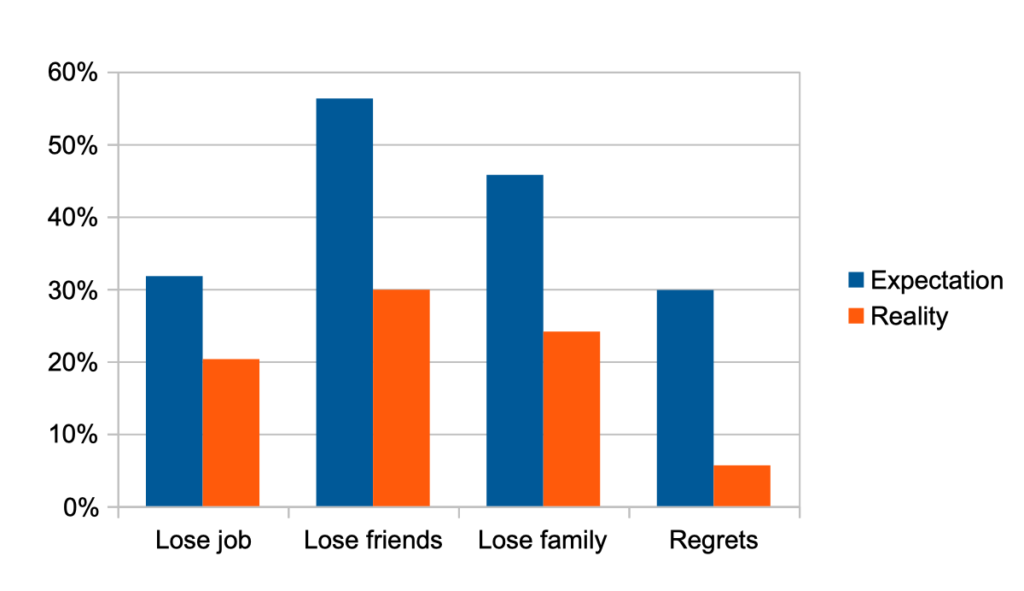
Fig 7. Answers to “Did you lose a job / job opportunity / friend / family and do you regret coming out?” and “Do you think you would lose a job / job opportunity / friend / family and you would regret coming out?”
📌 18% of closeted respondents believe they would have a negative response from the people around them after coming out, when in reality 6% of respondents who have come out actually did.
📌 Only 21% of closeted respondents think that people around them would react very well, when more than 50% of respondents who have come out had positive reactions after coming out.
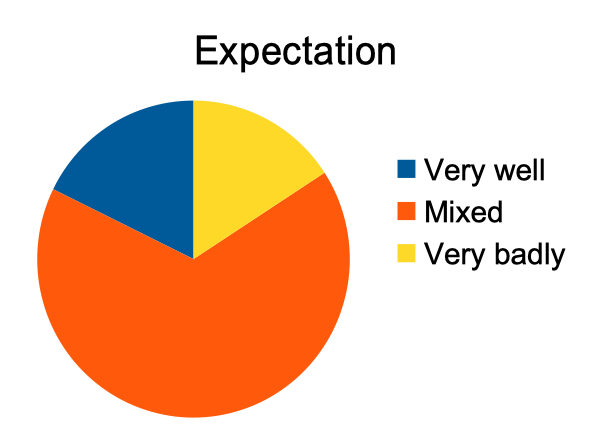
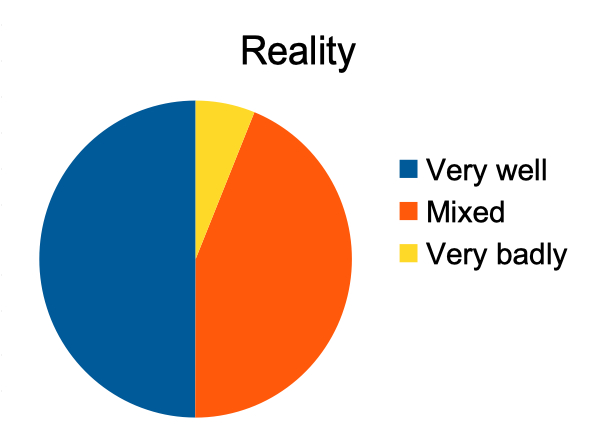
Fig 8. Answers to “How well did people around you react when you came out?” and “How do you think people around you will react when you come out?”
We can easily see an interesting thing in these results. Closeted respondents are pessimistic regarding the consequences of coming out.
But these are just numbers. In reality we can imagine that some of them don’t do it because they know that their family or friends will react badly. At the same time, it’s easier to come out when people around are open minded.
Conclusion
After analyzing our data, we came up with a positive conclusion. Many respondents said that the negative consequences of coming out happened less than they expected. Of the percentage of people who came out, almost all of them have no regrets.
Though we did our research thoroughly, please keep in mind that the respondents of this survey were limited to the userbase of My Transgender Date.
Also, we do not claim to be statisticians, so the findings of this study are to be taken as they are. Any organizations or professional statisticians who want to use our data to make their own analysis are welcome to communicate their interest in partnering up with us (bear in mind the raw data are anonymized in order to protect our members’ privacy). We hope that in light of this study we have gathered significant data to help better understand the trans community.
Lastly, we would like to address every single member of our community, especially the ones who have experienced the repercussions of coming out. We extend our support to you and everyone else experiencing the same challenges.
We would like to express our gratitude for taking part in this survey, and for being a part of our community. Please don’t hesitate to give your support to others in the comment section, and to share this article to a person who may need it.
Many thanks also to all who took the time to answer our survey and made this study possible.
Your site is by far the best for meeting transgender women. Many thanks
However, I think the comparison of fear of coming out vs. actual results of coming out are a little misguided, and the fear is justified. Fear is related to risk, and those actual percentages of job and family loss are excessively high. So the fear is justified based on the high risk. In fact, I'm surprised that with such a high risk, the fear of the risks isn't closer to 100%.
Think of it this way: if an operation had a 20 to 30% chance of dying from the surgery, what would be the average respondent's answer about fear of the operation. Much higher than 50% I expect.
Thanks again for all the good work you do for this community and providing a safe place to further our growth.
Thanks for your comment! I agree that fears are definitely justified. 25% of trans women losing a job / job opportunity is not small!
I like your analogy with the operation. I think the difference is that patients are always told the risks before an operation (at least they should be). While trans women don't necessarily know the chances beforehand (eg of losing their job for example), which would explain why their estimations aren't close to 100%.
We hope our small study will help trans women be more informed of the risks, statistically speaking, so they can make more informed decisions at least!